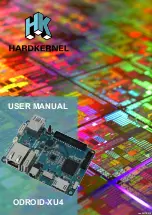
8
ODROID-XU4 USER MANUAL
Technical specifications
Processor
Samsung Exynos5422 Cortex™-A15 2Ghz and Cortex™-A7 Octa
core CPUs with Mali Mali-T628 MP6 GPU
Storage
There are two different methods of storage for the operating sys-
tem. The first is by using a microSD Card and another is by inserting
an eMMC module, which is normally used for storage for smartphones
and digital cameras.
eMMC 5.0 module socket
8GB/64GB : Toshiba
16GB/32GB : Sandisk iNAND Extreme
The eMMC storage access time is 2-3 times faster than the SD
card. You can purchase 4 size options: 8GB, 16GB, 32GB and 64GB.
Using an eMMC module will increase speed and responsiveness, sim-
ilar to the way in which upgrading to a Solid State Drive (SSD) in a
typical PC also improves performance over a mechanical hard drive
(HDD).
Micro Secure Digital (microSD) card slot
The ODROID-XU4 can utilize a newer UHS-1 SD model, which
is about twice as fast as a class 10 card. There are some microSD
cards which cause an additional boot delay time of around 30 sec-
onds. According to our testing, most Sandisk microSD cards don’t
cause a long boot delay. The ODROID-XU4 model is compatible with
a wide array of microSD cards, but class 10 cards or above are highly
recommended.
5V 4A DC input
The DC input is for 5V power input, with an inner diameter of
2.1mm, and an outer diameter of 5.5mm.
USB host ports
There is one USB 2.0 host port and two USB 3.0 ports. You can
plug a keyboard, mouse, WiFi adapter, storage or many other devic-
es into these ports. You can also charge your smartphone with it! If
you need more than 3 ports, you can use an external USB hub. A
self-powered hub will also reduce the power load on the main device.
Chapter 1













































